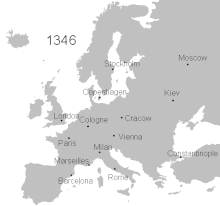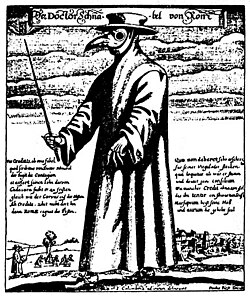Black Death


The Black Death was a pandemic in Europe and Asia during the 14th century.
This outbreak of disease was at its worst between 1347 and 1351.
It killed between 25 million and 50 million people across Europe.[1]
Historians cannot be sure which disease caused the Black Death. However, most think that it was the bubonic plague. That is a bacterial infection caused by the Yersinia pestis species of bacteria.[2]
The Black Death may have begun in Central Asia or East Asia. It definitely appeared in Crimea in 1347.[3] It was probably carried by fleas living on black rats, which traveled on Genoan ships and brought the plague to port cities around the Mediterranean. Rats may also have traveled along trade routes like the Silk Road and brought infected fleas to European cities. When the fleas bit humans, they infected them with the plague by injecting a bit of Y. pestis bacteria into the wound. Symptoms would start three to seven days later.
Not everybody agrees that plague caused the Black Death. Some historians have suggested that anthrax or a viral hemorrhagic fever caused the pandemic.
Impact[change | change source]
The disease killed around a third of Europe's population, but some areas were less affected than others. There were 75 to 200 million people across Eurasia that died during the pandemic.[1]
Until the 1700s, the plague seems to have reappeared in Europe at least once every generation. Some of the smaller plagues were more intense than others and caused more deaths. Later outbreaks include the Italian Plague of 1629–1631, the Great Plague of London (1665–1666), the Great Plague of Vienna (1679), the Great Plague of Marseille in 1720–1722, and the 1771 plague in Moscow. The most virulent form of the plague seems to have disappeared from Europe in the 18th century.
The Black Death had a very big effect on Europe's population. It changed Europe's social structure, which was a serious blow to the Roman Catholic Church and resulted in widespread persecution of minorities such as Jews, Muslims, foreigners, beggars, and lepers. The uncertainty of daily survival influenced people to live for the moment, as illustrated by Giovanni Boccaccio in The Decameron (1353).
At the time, 14th-century European writers called the pandemic the "Great Mortality". Later outbreaks made it become called the "Black Death".
Media[change | change source]

The Black Death appears in some modern literature and media, used as a subject or a setting. For example, Edgar Allan Poe's short story The Masque of the Red Death (1842) is set in an unnamed country during a fictional plague that shares many things in common with the Black Death.
Albert Camus's writings used that theme too. His novel The Plague (1947) was set against an outbreak of the plague in Algeria and discussed how people handle the epidemic.
Medical aspects[change | change source]
In humans, the bubonic plague causes fevers, severe flu symptoms, and buboes. The last are large swellings filled with pus that usually appear in the groin, under the arms, on the thighs, and behind the ears. Buboes are black and purple, which may be how the Black Death got its name. The disease was painful, and many victims died horrible deaths.
The medical knowledge of the time was based on Hippocrates's theory of humorism, which said the body consists of different fluids. If they are in harmony, a person is healthy. If they are not, disease results. Very often, diseases were also seen as a punishment from God.
The theory of humorism did not explain why disease spreads from one person to another. Most people thought that infection was caused by miasma ("bad air"). The bad air could come from within the earth and so cause the disease. Remedies against the disease included opening only north-facing windows, not sleeping during the day, and not working too hard.
In 1348, Philip VI of France asked the Faculty of Medicine of the University of Paris about the cause of the Black Death. It concluded that the pandemic had been caused by a bad conjunction of Jupiter, Saturn and Mars on 20 March 1345. Since that answer was based on astrology, many people believed it, and it was translated into many languages.
Because nobody understood what caused the plague, doctors had no effective treatments. Often, doctors simply told their patients to go to Confession so that their sins would be forgiven if they died. Eventually, the pandemic caused doctors to change their ideas about how the human body worked. Just 200 years later, Girolamo Fracastoro discovered that diseases spread through infection.
Twelve plague outbreaks in Australia between 1900 and 1925 caused over 1,000 deaths, mainly in Sydney. That led to a Public Health Department, which did some leading-edge research. It found that plague transmission from rat fleas to humans by the bacillus Yersinia pestis.[4]
Germ warfare[change | change source]
Mongol forces used the plague as a biological weapon in 1347. That was one of the earliest uses of germ warfare in history.[5]
In Crimea, Mongol forces were fighting for control of Caffa, a Black Sea port (now Feodosiya, Ukraine). At the time, Caffa was a Genoese trade centre. Mongol forces began a siege. During the siege, they are reported to have catapulted plague-infested bodies over the walls into the city.[5] Genoans fled the siege by using ships. Some historians believe the Caffa refugees brought the plague back to Italy with them, which started the pandemic.[5]
Related pages[change | change source]
References[change | change source]
- ↑ 1.0 1.1 Benedictow, Ole (2021). The complete history of the Black Death. Suffolk, UK: The Boydell Press. p. 876. ISBN 978-1-78744-931-2.
- ↑ "Plague". World Health Organization. October 2017. Archived from the original on 24 April 2015. Retrieved 8 November 2017.
- ↑ 3.0 3.1 Sources for origins
- Hollingsworth, Julia. "Black Death in China: A history of plagues, from ancient times to now". CNN. Archived from the original on 6 March 2020. Retrieved 24 March 2020.
- Benedictow 2004, pp. 50–51
- Bramanti et al. 2016, pp. 1–26
- Wade, Nicholas (2010-10-31). "Europe's Plagues Came From China, Study Finds". The New York Times. ISSN 0362-4331. Archived from the original on 4 November 2010. Retrieved 2020-03-01.
- "Black Death | Causes, Facts, and Consequences". Encyclopædia Britannica. Archived from the original on 9 July 2019. Retrieved 2020-03-01.
- Sussman 2011
- ↑ Bubonic Plague comes to Sydney in 1900 Archived 10 February 2012 at the Wayback Machine, University of Sydney, Sydney Medical School
- ↑ 5.0 5.1 5.2 "Biological Weapons in History". www.britannica.com. Britannica. Retrieved January 7, 2022.
Other websites[change | change source]
Primary sources online[change | change source]
- Agnolo di Tura's account
- Gabriele de' Mussi's account Archived 2006-10-29 at the Wayback Machine
- Marchionne di Coppo di Stefano Buonaiuti's account Archived 2007-02-03 at the Wayback Machine
- A Petrarch account Archived 2007-02-04 at the Wayback Machine and More quotes from Petrarch Archived 2007-02-04 at the Wayback Machine
Secondary sources online[change | change source]
- The History Guide "Satan Triumphant: The Black Death"
- Symptoms, causes, pictures of bubonic plague
- Overview of the black death
- BBC news story on controversy over Black Death origins
- Examination of "Ring around the Rosy"'s relationship to the plague
- Black Death Overview from BBC history
- Plague and Public Health in Renaissance Europe. Primary source documents and analyisis
- Secrets of the Dead . Mystery of the Black Death Archived 2014-03-25 at the Wayback Machine PBS
- Pandemics in Eastern Europe Archived 2011-06-05 at the Wayback Machine
